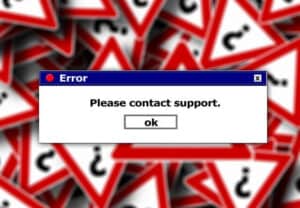Bigger Isn’t Always Better for Licensing Management Software.
The advent of the internet age has proven to be a boon for organizations and individuals alike. For the most part, promises of improved productivity and more efficient operations have been realized. There is software for everything from accounting and time tracking to automating online and social media marketing. For licensing bodies specifically, cloud computing applications streamline the registration process for both members and staff. They can also help reduce bias, and maintain detailed records for competency audits. Computer technology has even made submitting reports to CIHI or other health information organizations simpler and more efficient.
Yet for all the improvements online apps and cloud computing have brought to our lives, they’re not without their complications. The security of your membership’s information is just one example, and we’ve written about protecting personal information before. But there’s another important issue about your software that may not be addressed as often as it should be and that’s how updates are implemented.
Big Updates Can Mean Big Problems.
Updates are an important part of software; they fix security issues and glitches, refine the software and even bring new features. At the same time, improperly handled updates can cause serious disruptions for both your staff and your membership.
Upgrades can be problematic.
 Accepting a software update can occasionally wreak havoc on your systems because of configuration conflicts, bugs in the programming and even hardware glitches. We’ve all heard horror stories of iPhone updates rendering phones useless, or Windows updates rendering desktop computers unusable. Given how important registrant information is to licensing bodies for tracking practicing members, competency audits and other day-to-day functions, it’s understandable why licensors might be reluctant to take up an update.
Accepting a software update can occasionally wreak havoc on your systems because of configuration conflicts, bugs in the programming and even hardware glitches. We’ve all heard horror stories of iPhone updates rendering phones useless, or Windows updates rendering desktop computers unusable. Given how important registrant information is to licensing bodies for tracking practicing members, competency audits and other day-to-day functions, it’s understandable why licensors might be reluctant to take up an update.
Mandatory and Inconvenient.
Additionally, the option to take an update is becoming increasingly rare. Cloud software regularly forces new version on users, but it’s becoming increasingly common for on premise applications to make updates mandatory as well. This can be incredibly inconvenient if they arrive at an inopportune time. Updates may also come with graphical changes to the user interface that can be confusing for the end user.
Testing requires resources.
If you want to avoid serious problems when updating your software then it’s critical to test the update thoroughly. It also means you’ll have to invest time and manpower into the testing phase. There’s even the possibility you’ll need additional hardware to test on, making the update potentially even more expensive.
On the other hand, if you’re using a hosted solution then you’re effectively outsourcing the testing of your updates. You won’t have to worry about finding the resources to conduct a thorough test, but you’re also giving up control over the testing process. Oftentimes this can be enough of a concern that your college will insist on taking on the testing process to ensure the most important features of their software work properly with the update. That’s when they often discover that they lack the resources to conduct the test properly. Although leaving update testing to host providers does mean giving up some control over testing, an experienced team will know the details of license management software. They’ll also be familiar with your system, and be able to provide thorough testing to ensure compatibility with your licensing body software’s unique features.
Smaller Updates More Often.
The answer to problems associated with the occasional big update is to find a vendor that provides smaller updates more often. Known as continuous delivery, regularly developing small updates to provide new features, configuration changes and bug fixes is more stable, less expensive, and produces better quality products. This is especially important to licensing bodies, where maintaining the integrity of registrant information is paramount. Smaller updates pose less risk of losing registrations, continuing competency information, or downtime during renewals.
Smaller updates also have the benefit of reduced development time. For example, if your vendor provides a modular software framework like Alinity, you can request specific, targeted features for your implementation. This means your software has the potential to be continually refined. Smaller updates with shorter lead times mean more agile software that can respond to changes in your staff and memberships needs as they develop.
Update Fatigue.
 As with any process, finding the right software update schedule is a balancing act. Large occasional updates can be cumbersome and difficult to implement. However too many small updates can contribute to update fatigue. This the feeling of frustration that often accompanies the endless cycle of software updating on our devices. From updates to operating systems for your desktop to mobile app updates, it seems like we’re constantly under pressure to take on the latest version of anything and everything.
As with any process, finding the right software update schedule is a balancing act. Large occasional updates can be cumbersome and difficult to implement. However too many small updates can contribute to update fatigue. This the feeling of frustration that often accompanies the endless cycle of software updating on our devices. From updates to operating systems for your desktop to mobile app updates, it seems like we’re constantly under pressure to take on the latest version of anything and everything.
Many software updates contain important patches for security, so there’s no getting away from updating. That doesn’t mean the symptoms of update fatigue can’t be eased though. In some cases it can be as easy as turning on automatic updating for your mobile devices and tablets. Similarly, you may consider allowing your developer or vendor to implement continuous deployment. Like automatic updating, continuous deployment takes continuous delivery one step further, and pushes updates into your system automatically.
Regardless of how licensing bodies decide to update their software, it’s important to understand all of the available options. Talk with your software vendor about the risks and benefits of each when requesting changes and customizations. This will help both you and your vendor do develop an update schedule that works for your organization.
